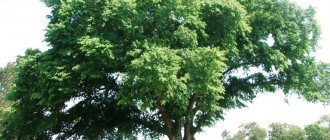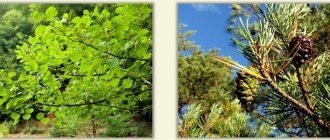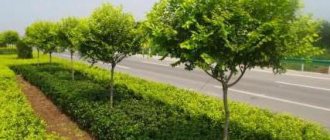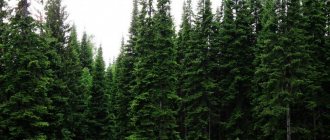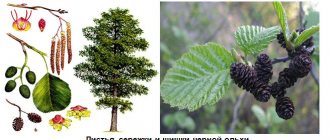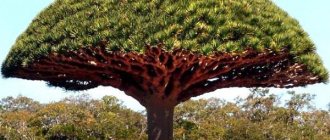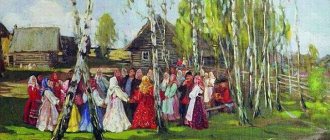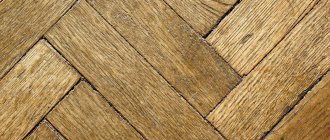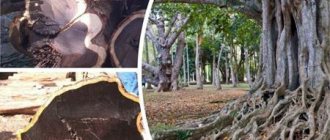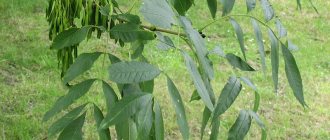When the sailors first set foot on the soil of North America, they were amazed and delighted by the impressive size and unusual appearance of the tree, which grows only in this region. Since their distribution area is the highlands of California, they are called California pines or mammoth trees.
The English botanist John Lindley, who studied the tree, decided to give it a scientific name in honor of Wellington, the commander who defeated Napoleon - Wellingtonia gigantea. But American botanists “rebaptized” it, giving the name of their national hero; the plant began to be called Washingtonia gigantea. But this name was not final either. In the course of scientific research, it was revealed that the tree is a new species, which is part of a genus that has long been known to science, containing the plant - evergreen sequoia (Sequoia sempervirens). This representative of the sequoia genus is smaller in size, but is distinguished by its longevity. As a result, the newly discovered tree received the specific name giant sequoia.
By the way, the word sequoia itself is not a simple set of sounds or the ordinal arrangement of seeds, as some botanists assumed. Sequoyah is the name of one of the national heroes of the Cherokee Indian tribe. Thus, the name of the plants immortalized the memory of the leader who fought against the European invasion of America, who created a syllabary (writing) for his people and even published the Cherokee Phoenix newspaper in this language.
Sequoia Tree Facts
The key point in describing a sequoia tree is its height. In their natural habitat, giant sequoias can live up to 3,000 years and grow more than 90 meters tall, with mature trees typically reaching a height of 60 to 80 meters.
However, when grown at home, the tree usually reaches only 12-15 meters in height.
Giant sequoias grow best in full sun and tolerate light well. They like consistently moist (but not soggy) climates and soils. Sequoias prefer deep, loose, well-drained, sandy loam soils. Giant sequoias do not tolerate dry soils, clay soils, or extreme temperatures.
Water and soil are critical to redwood trees. In their natural habitat, redwood trees depend on winter snow cover. When the snowpack melts, water sinks into the ground and feeds the redwood trees. Redwoods require a constant supply of water at the root level to grow, but do not like muddy or swampy conditions.
Spreading
Along a narrow line along the Pacific coast of the United States, quite significant forests of redwoods grow. They stretch from southwestern Oregon to the Santa Lucia Mountain Range in California. Trees prefer a height of 600-900 m above sea level. This explains that they can be seen on a strip 750 km long, the thickness of which is only 8-75 km. Some specimens can be found on the very shore, and some grow in the mountains at an altitude of up to 920 m above sea level.
In addition to national parks and reserves in Oregon and California in the USA, the sequoia tree can be seen in the countries:
- Great Britain;
- Hawaii;
- Italy;
- Canada;
- New Zealand;
- SOUTH AFRICA.
To grow, the tree needs a humid maritime climate, like in its homeland - on the Pacific coast of the North American continent. This explains the distribution area. The seeds germinate and take root where the climate is suitable for the sequoia. Frost resistance ranges from -12.1-17.7 °C for young trees that grow in forests in America, but increases over time. The tree was brought to the European mainland only in 1853, after which it appeared in private gardens, as well as in public parks and squares.
In Russia, you can meet sequoia in the mountains of the Western Caucasus and on the southern coast of Crimea. In Ukraine, 3 sequoias grow in the Transcarpathian arboretum Berezinka, which made it possible to assert: in forest conditions, trees higher than 30 m can survive at winter temperatures down to -23.2 ° C.
Collecting seeds
If you decide to have this representative in your garden, you will be faced with the question of how to grow a sequoia tree. As you may have guessed, to do this, the first thing you need to do is collect the seeds. You have 2 options: collect them or order them.
Collecting seeds, while not the most efficient method, is probably the most rewarding as you go from collecting a pine cone on the ground to creating your own tree. You can also trace your seedling's genealogy since you already know the parent tree.
If you decide to collect seed, try to find a mature redwood tree and look for green buds on the ground. They have the highest chance of germination (20 to 40%). Let them dry in the house. The buds will open slowly.
Another solution is to order seeds. These seeds come from mature trees and have a high germination rate (>40%). Look for the Latin name Sequoiadendron giganteum.
Where does it grow
Scientists say that many millions of years ago, gigantic sequoias grew throughout the northern hemisphere of the Earth.
Today, in their natural form, these giants grow in a narrow strip 720 km long along the coast of the Pacific Ocean in North America, California.
Here, ideal conditions for them are high humidity, frequent fog and the absence of sweltering heat. It is interesting that the sequoia never moves far from the coast; it can no longer be found further than 70 km from the coast.
This tree is grown artificially in Canada, Mexico, Great Britain, Portugal, Italy, South Africa, and New Zealand. In the Nikitsky Botanical Garden in Crimea, the oldest sequoia in Europe grows, which is almost 170 years old.
Sequoia can also be found in the Caucasus, in the south of Central Asia, and in the Transcarpathian regions. Four sequoia trees grow in China, in the Sichuan province.
But wherever this tree is planted artificially, it does not reach such enormous sizes as in its natural homeland in North America.
Planting seeds
It's time to plant the seeds in the soil. Prepare individual pots using a standard potting mix. Planting and caring for seedlings requires moist but well-drained soil.
Humidity is a key factor in the success of growing seedlings. If you ever let the soil dry out too much, the seedlings will almost certainly die. However, too much water, the base of the seedling will rot and the plant will fall to the ground.
To prevent mold and fungal infestations, add a fungicide to the potting mix, stir, and fill the pots. Make a hole in the center and place the already sprouted seed. Lightly water the soil.
Sequoia. Beneficial features
Sequoia is not used in folk medicine, but the plant extract is contained in dietary supplements intended to strengthen bones and joints.
READ Thuja occidentalis Smaragd how to grow it yourself and what you need to know?
Continuing the topic about exotic tree species that are often found on sale today, I would like to make special mention of such a tree as sequoia. Redwood wood is highly prized among woodworkers as well as consumers. Let's figure out what kind of miracle properties this material has.
Sequoia seed germination
Under natural conditions, fire can be destructive to forests, but it also promotes the germination of giant sequoia trees. Redwood cones can store seeds for up to 20 years unless fire, squirrels or cone beetles remove the seeds. Unfortunately, the seeds also need to be planted on cleared soil. However, less than 1 percent of seeds germinate under natural conditions.
In addition to fire-cleaned soil, redwood seeds require soil moisture between 5 and 16 percent. In nature, seeds should germinate within 1 cm of the soil surface.
Giant sequoia seeds and trees require fertile, mineral-rich soil to nourish the new plant so the tree can grow and develop. Moderate temperatures without prolonged sun exposure also affect seed germination.
The seed will not even germinate if exposed to sunlight for 10 to 20 days. However, once the tree begins to grow, it must have enough sunlight.
History of origin
Today, scientists have concluded that sequoia appeared on Earth 140 million years ago.
This is proven by the found and studied fossils and other geological deposits, on the basis of which it is possible to calculate the approximate period of the appearance of a huge natural creature on Earth. In ancient times, sequoia spread to territories that are today known as France, Japan and even the New Siberian Islands. The giant tree existed already in the Jurassic period, when the planet was inhabited by dinosaurs, and even then forests occupied vast areas in the northern hemisphere. According to experts, 50 million years ago, due to the fact that the temperature on Earth dropped significantly, the Ice Age began. The giant sequoia has stopped spreading across the planet and its range has greatly decreased. After warming, these trees remained at the same stage of development and remained growing in only one region.
The first to discover giant sequoias were the Spaniards, who in 1769 sent an expedition to the area of present-day San Francisco. Mammoth trees got their name - sequoia - from the linguist and botanist S. Endlifer, who was the first to call them “red trees”. Initially, no one knew what to do with these huge centenarians. They were practically not used, this is due to the fact that strong trunks were almost impossible to fell, since neither an ax nor a saw could take them. On top of that, the wood turned out to be absolutely unsuitable for construction, such as pine or other conifers. The giant sequoia forests were even destroyed in 1848. By the time more than half of the trees had already been destroyed, the US authorities decided to begin protecting the amazing creatures of nature.
Landing in the ground
When the plants reach 10-15 centimeters in height, it is better to remove them from the pot and grow them directly in the ground. This will ensure they don't dry out and give the roots room to spread.
An important criterion is the choice of location for planting the tree. Once you find a large enough spot (radius 10), you can plant the sequoia in its final location.
Just as planting a redwood tree is easy, be sure to add a slow-release conifer fertilizer to increase root production next year.
If you have animals, protect the young tree with chicken wire during the early years of growth as they like to chew on buds and young stems.
Wood
| Scientific name – | Sequoia sempervirens |
| Density – | 415 kg/m³26 lb/ft³ |
| Hard Yanka – | 2 kN450 lbf |
| Bending strength – | 61.7 MPa8950 lbf/in² |
| Modulus of elasticity in bending – | 8.41 GPa1220000 lbf/in² |
| Ultimate compressive strength along the fibers – | 39.2 MPa5690 lbf/in² |
| Shrinkage (radial – tangential – volumetric) – | 2.4% – 4.7% – 6.9%T/R = 2.0 |
| Other names – | Redwood, Sequoia, Coast Redwood, California Redwood, Vavona (burl) |
| Spreading - | Pacific Coast of North America (Southwestern Oregon to Central California) |
No related species found
Caring for a young sequoia
Caring for sequoia poses complex challenges for gardeners. Water availability is the most important factor in successfully growing giant sequoia trees. They need a lot of water but do not do well in wet soils. Drought, unlike soggy soil, is also extremely detrimental to sequoia growth, affecting even mature trees.
Equally important is soil fertility, which can be improved by adding specially formulated sequoia fertilizers or choosing a planting site with fertile soil.
Young redwood trees develop extensive, shallow root systems very quickly. To absorb the required amount of water and nutrients, sequoia trees have tiny white roots that are very sensitive.
In fact, visitors to the giant sequoias are asked to stay on the trails to avoid disturbing the soil and damaging the food roots. The same should be observed at home for young sequoia trees. When replanting trees, be extremely careful when removing trees from their pot or location without exposing or damaging the roots.
Young redwood trees that have adequate moisture and sunlight can grow 0.60 to 1.2 meters per year for the first 50 to 100 years. The diameter, however, can increase at a rate of up to 2.5 cm per year.
Provided there is suitable soil, sufficient moisture and sufficient sunlight after germination, redwood trees grown as seedlings should be planted 30 to 60 feet apart to allow sufficient room to develop.
Application
As mentioned above, red and mammoth wood has all the positive characteristics inherent in coniferous species, including immunity to damage by biopests, microorganisms, fungi, and mold. Despite its inherent high humidity, due to its growth in coastal regions, wood shrinkage is insignificant; when drying, it does not warp, and microcracks do not form in it. Giants growing in optimal natural conditions quickly increase their mass, and the volume of wood obtained from one specimen can be 1000-2500 kg. Therefore, sequoia is used not only to improve the landscape, but is also cultivated in forestry.
Mahogany (Sequoia sempervirens) is in particular demand among consumers, and the quality of the material depends on the growing conditions of the tree and on the layers of the trunk from which it is obtained:
- thin, loose sapwood of a light creamy color;
- heartwood, original carmine, cherry, light brown shade with an interesting structure, characterized by the presence of a contrasting pattern formed by annual rings and pith rays;
- young layers have a lower density, but consist of straight fibers.
The service life of products made from sequoia exceeds 40 years; in conditions of high humidity, in contact with soil it reaches up to 25 years.
READ Interesting facts about Karelian birch
The valuable material is used to solve a wide variety of problems related to construction, the furniture industry, cladding and decorative cladding. Made from odorless wood, boxes, barrels, containers and boxes are perfect for storing cigars, honey, molasses, and spices. In America, it is used to cover the premises of yachts, railway cars, car trailers; they make stairs, benches, window frames, doors, even tiles, posts and sleepers. Since it is resistant to flame, it was once used in the manufacture of fire firewalls.
Among the plants known to modern botanists, the “Father of Forests” had the greatest height. Its height was 135 m. Of the sequoias that have survived to this day, the record belongs to Hyperion - 115.6 m, this is the tallest tree on our planet. It grows in Redwood Park (northern California).
Scientists have long been interested in the question: what is the maximum height that a plant “living” on planet Earth can reach? According to the theoretical calculations performed, it turned out that due to the limitation imposed by gravity, the growth limit of representatives of the plant world is at around 122-130 m. The higher the trunk rises, the more difficult it is for the tree to deliver from the roots to the cells located at the top the necessary for their life activity amount of moisture, nutrients. Without the opportunity to fully develop, the leaves at the top are always smaller in size.
Sequoia tree photo
Sequoia in industry
Sequoia is also used in the food industry. Honey and molasses are stored in sequoia barrels. And tobacco manufacturers have long appreciated this odorless wood, and therefore boxes made from sequoia are often used to transport tobacco and tobacco products.
In addition, this tree does not need additional impregnation with insect repellent compounds, since the chemicals present in sequoia wood themselves repel insects from it. The ability to avoid the use of chemicals is extremely important specifically for the production of furniture for children, since it makes the products as safe as possible and virtually eliminates the risk of allergies.
This was one of the reasons that Californian redwood is preferred by many companies producing products for children, and the Rainbow company uses Californian redwood wood as the main element for its play complexes.
That is why, when faced with the choice of which children's play set to buy, you should pay attention to those in the production of which sequoia was used. It is precisely these play complexes that turn out to be the most durable and safe, and therefore can serve not only your children, but also your grandchildren.
So, reliable Californian sequoia in construction is an excellent, environmentally friendly material with enormous potential.
Redwood tunnels in the USA
At the turn of the 19th and 20th centuries. In North America, road tunnels began to be built en masse through giant sequoias. They became a popular tourist attraction, attracting numerous visitors to the parks and their hotels. However, this barbaric fashion was quickly banned by the authorities. Since then, only a few tunnels have remained in the United States. One of them, namely the California Tunnel Tree, is shown in the photo. It was taken in the Mariposa Grove Grove of Yosemite National Park.
This tunnel was made in 1095 to accommodate horse-drawn carriages. Nowadays cyclists and pedestrians pass through it. In the same park, in the Tulumne Grove grove, there is another similar sequoiadendron - Dead Tunnel Tree.
Road tunnels are preserved in several evergreen redwood trees. The most famous is the Chandelier Tree in the Drive-Thru Tree Park in Legette. The tunnel, 2.06 m high and 1.8 m wide, was made in a 95-meter tree in the 30s of the last century. There is a $5 fee to travel by car.
Sequoia grove in Crimea
History of appearance
In the middle of the 20th century. Nikitsky Garden researcher Gennady Yaroslavtsev undertook an experiment on growing sequoiadendron in mountainous areas. The landing site - near Kutuzovskoye Lake on the slopes of the Chatyr-Dag plateau - was recommended by Anatoly Potapenko, an employee of the Alushtinsky forestry. The grove at an altitude of 850 m was planted in 1964 near a spring, which is the source of water for the lake. When choosing a location, the moisture-loving nature of these trees was taken into account.
To protect the seedlings from wild boars, deer, and people, Crimean pines were planted around them. The new trees were looked after by a forester who lived nearby, an acquaintance of Potapenko.
The experiment was a success. Now, in two sections of the grove, approximately 150 20-meter sequoiadendrons grow, which earned Yaroslavtsev a doctorate. The Crimean pines that once masked them are drying up, unable to withstand the competition. Kutuzovskoe Lake has also dried up almost completely.
How to get there
The grove is located on the southern slope of the Chatyr-Dag mountain plateau, near the Kutuzov Lake tourist site. First, by car or public transport, you need to get to the well-known trolleybus monument on the Angarsk Pass. A little higher, near the ski school, there is a parking lot.
From here starts a hiking route through the deciduous forest to the grove with coordinates 44.738158, 34.334936. The landmark on the way is a power line, after which you should turn south to the lake. The duration of the walking route, starting with a gentle ascent, is approximately 40 minutes.
